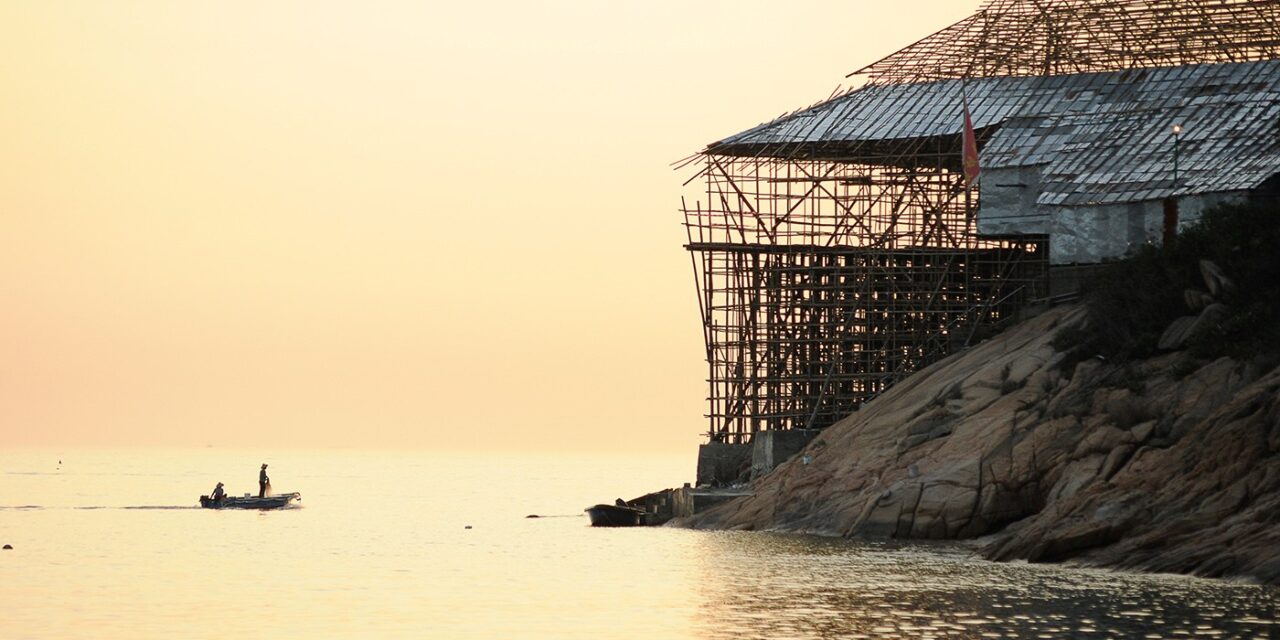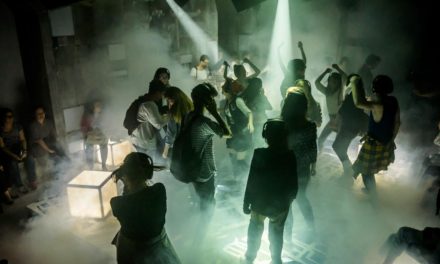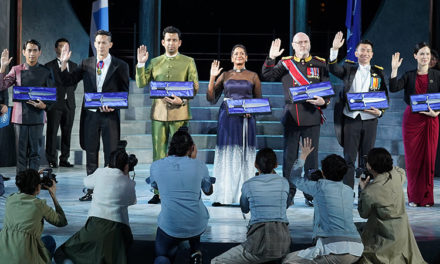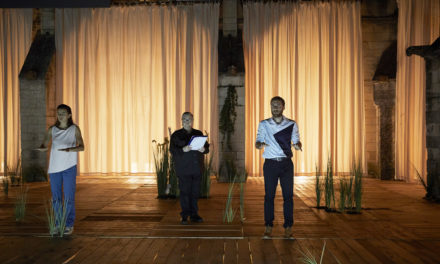For generations, bamboo theatres have been a thread that ties together Hong Kong’s present and past. Made of bamboo sticks and clad with metal sheets to protect them from the weather, they are built all over the city to celebrate traditional festivals, as documentarian Cheuk Cheung has explored in his work. And while many appreciate the ingenuity of their construction, the story of the people who build them has often slipped through the cracks.

Steven giving Islanders a helping hand with moving the surplus building material
That’s what motivated me to travel to Hong Kong’s southernmost island, Po Toi, with fourth-generation bamboo master Chan Yuk-Kwong. He runs one of Hong Kong’s two bamboo theatre companies and his life has revolved around the craft since the age of 13. Now, more than 30 years later, he is just as driven as he was back then. His portfolio includes the critically acclaimed West Kowloon Bamboo Theatre, which his crew built in 2014, according to a design by architect Raymond Fung, with a programme curated by director Frederic Mao. And Chan is already passing the torch onto a new generation. His 29-year-old son, Smallman, has already worked in the industry for 15 years.
Their most recent project was a particularly complicated theatre built in front of Po Toi’s Tin Hau Temple, which has safeguarded the island since 1835. Straddling the edge of a rocky cliff, it looks out over the South China Sea, whose bounty has sustained generations of Islanders. On a foggy night, as waves of ship horns cascade upon the shore, it is not difficult to imagine navigating through the murky darkness, looking for Tin Hau’s divine protection for comfort.

Smallman Chan laying metal sheets on the roof to protect the audience from rain and wind
My arrival on Po Toi was greeted by a committee of island residents who hosted a simple but solemn ceremony to notify Tin Hau that the construction of the bamboo theatre was about to commence. “When I was little, the bamboo theatre was already built on this cliff the very same way,” a committee member told me. He reckoned the tradition extended back at least a century.
Nearby, the sound of laughter led me to Chan, who was playing cards with his eight-man crew: his son Smallman, Kenny Lee Ka-Chun, Steven Chan, George Yeung, Ho Shing-to, Uncle Ching, Sunny Cheng—nicknamed Jackal—and a man who introduced himself as Bell, explaining that the others called him Char Siu Bau.
They wrapped up their game and we all headed back to the temple. While the crew performed their own ceremony to ensure a safe construction process, I discovered that preparation for the theatre had already begun. Construction materials were piled up on raised platforms between the temple and the cliff, including fir logs (Shān 杉), Moso bamboo (Máo zhú 茅竹) and pole bamboo (Gāo zhú 篙竹). It turned out that transporting the bamboo was no easy feat. It had to be done on the days of highest tide, which are the first, third, 15th and 18th day of each month, according to the lunar calendar.

The crew lifting, passing and moving the material upward under foggy, sunny and windy conditions
Lee—a walking encyclopedia of bamboo theatre history—gave me a quick 101. He explained that the techniques they use to build bamboo theatres date back to the Qing Dynasty (1644-1911), and while they were once common throughout southern China, only Hong Kong still maintains the tradition. Lee also said there have been some technical modifications that have streamlined the construction process. By contrast, mainland China has simply banned the construction of bamboo theatres.
Bamboo theatres are normally built on a level sports ground, or in the plaza in front of a temple. But the cliffside location of the Po Toi Tin Hau Temple raises some technical challenges. Normally, construction would start from the stage, which provides the fundamental measurements the whole theatre is based upon. But in this case, the workers needed to start from the base, next to the water. The crew passes each heavy piece of material upward like an army of ants.
It isn’t only the site that is challenging. The bamboo workers are completely at the mercy of the weather: wind, sun and rain all pose their own test to physical and mental strength. “At this time of the year, northeasterly wind hits this area. Some of us can’t even lift and move a log,” said Lee with a grin.

Steve Chan

Smallman Chang

Master Chang Yuk-Kwong

George Yeung
As he spoke, the team sprang to action under Chan’s lead. They surveyed the material and decided with astonishing swiftness where each bamboo pole should go. The air was filled with excitement and the workers bantered, teasing Chan and Lee—the bosses—while trading barbs with each other. The snark was good-natured; everyone seemed uplifted and motivated.
A blueprint was nowhere to be seen. The workers all seemed instinctively aware of where to go and what to do. Some started hoisting fir logs while others checked to see if they were correctly positioned, using only their naked eye to evaluate. They arranged bamboo rods into a structural grid, tying pieces together with strips of nylon, and began climbing the structure, adding bamboo where it was needed. Watching them was like watching a Cirque du Soleil show; the acrobatics were just as impressive.

Char Siu Bao

Sunny Chen (AKA “Jackel”)

Lee Ka Chun Kenny, the senior master

Uncle Ching
None of the workers were harnessed as they leapt between bamboo poles, although such safety equipment is technically required by the Labour Department. “Attaching ourselves to any part of the structure is simply not practical,” said Lee with matter-of-fact certainty. He said safety ropes and harnesses would do more harm than good. “As we move along, it can easily become entangled and we can trip ourselves and even worse, others. Working without protection demands us to remain highly alert at all times. It keeps us safe.”
The bamboo theatre rises 60 feet from its lowest to highest points – about the height of a seven-story building. Most theatres are built in a shape known as the Giant Bronze Bell (Dà jīn zhōng 大金鐘)—perhaps a reference to the ritual bells used in ceremonies—but the Po Toi version is a variation known as the Dragon Boat Yard (Lóng chuánchǎng 龍船廠), which resembles the sheds traditionally used to store dragon boats. The Giant Bronze Bell’s roof narrows to a more dramatic point, whereas the Dragon Boat Yard does not, the better to accommodate the unusual structure of the Po Toi theatre.

Masters enjoying a moment of stillness
Getting a phone signal on Po Toi is like winning a lottery. It just so happened that the cliff on the other side of the temple was a particularly lucky spot. As the theatre took shape, the workers took occasional breaks and wasted no time in heading to the cliff edge to connect with their loved ones: burly men exchanging sweet nothings in video chats with their wives and children. It was amusing but also quite touching.
Each worker is a master in his own right, able to work independently and yet in harmony with others. They are soloists in symphony with each other; a bamboo orchestra. This mutual dependence was clearly not built in a day. The core members of this crew have not only worked together for nearly 20 years, they have grown up together, playing ball games and going on field trips to cycle, play paintball or spend the day go-karting.

Platform for raising Huāpào above the Tin Hau Temple

Steve Chan getting materials ready before laying zinc sheets

At 30 feet high, Ho Shin To working away

Lee Ka Chun Kenny erecting one of the foundation pillars
Bamboo theatres keep the crew occupied from January till October. For the rest of the year, they depend on other kinds of scaffolding work; bamboo is still used for most construction in Hong Kong, whether it is to erect a massive skyscraper or fix an air conditioning unit on the 20th floor of an apartment building. Building a bamboo theatre gives the workers all the skills they need to do any kind of scaffolding work. And yet scaffolders are often relegated to the bottom rung in construction site hierarchies. For all their unique talent, they don’t get much respect.
This particular crew is the youngest in the industry, but they may well be the final generation of bamboo theatre masters. Each year, there is no shortage of people showing interest in learning the craft, but very few actually stay around due to the harsh working environment. “Many prefer being a general scaffolder,” explained Lee. “It is less technically demanding and they can see the results faster. They are not willing to sacrifice for art.” The impact could be significant. “Younger generations comparatively care less about keeping the traditions alive. Many festivals are at risk.”

Symmetry is being seen everywhere
The unique skills required by bamboo construction have always provided an opportunity for a certain kind of outsider – one who is a hard worker, often intuitive and insightful, but not well suited to the strictures of conventional Hong Kong life. The second youngest master in the group, Ng Shing-to, joined the industry eight years ago at the age of 22. “I’m not book smart,” he told me. “Hong Kong education didn’t suit me. But I constantly love looking for answers because it quenches my curiosities.”
He struggled to find a career that would satisfy him. It was thanks to his friend Smallman that he ended up working on bamboo theatres. “Smallman and I went way back,” he said. “As a teenager, he had already started building bamboo theatres and was soon working for Lee. They were always short of new blood so I was recruited as a young man.”
Though they may not enjoy respect in Hong Kong’s construction industry, bamboo theatre masters are celebrated in Hong Kong’s rural areas. They are often treated to free or discounted boat rides and meals, with villagers treating them to poon choi feasts during festivals. “We sometimes mingle [with villagers] over beers and they also make sure we have a mahjong set or other games.”

Zinc Sheet being laid and secured

A view from the main pier
On Poi Toi, the workers are allowed to sleep in the rural committee office, and local residents loan them jackets from the local dragon boat club to keep them warm when the wind picks up and temperatures drop. To return the favour, the masters go the extra mile by adding a special platform inside the bamboo theatre. During the Tin Hau Festival, islanders use it to raise floral paper offerings (Huāpào 花炮), which would normally be hoisted elsewhere, but can’t on Po Toi because of the lack of space.
The bamboo masters swear like dockers and smoke like chimneys, but there is a lot more to them than meets the eye. Many of them have depth, talents, dreams, hopes, aspirations, or even a touch of chivalry hidden under their tough exterior. George Yeung has built bamboo theatres for over 20 years. He is a Buddhist, a devoted vegetarian and a rapper who once performed in a hip hop group. He told me he loves his work because he loves bamboo. “Bamboo surviving in adverse weather conditions inspires me to overcome obstacles,” he said. To him, the characteristics of bamboo embody some traditional Chinese virtues. “The hollow culms represent magnanimity while the segments symbolise integrity.”

Hong Kong’s most extraordinary bamboo theatre hanging on a cliff
I asked him what makes a great bamboo theatre master. His expression became serious. “Conduct comes before skills,” he said. “Bamboo theatres and scaffolding are both intended for people to use so they cannot be taken lightly. Imagining my parents as the end-users always ensures I do a good job.” He also thinks about his fellow workers. He explained that Lee took him under his wing in the past and he would be willing to return the favour. “If he needs anything, I’ll always be there. No question asked,” he said. Building bamboo theatres isn’t just a job; it’s a community, a family, a way of life.
I only shadowed the workers for a short time. It was easy to see why their profession may not be well suited to everyone. The faint-hearted need not apply, and only people with a combination of contradictory traits can fit the bill. They must be agile yet patient, daring yet cautious, bold yet fastidious, analytical yet unafraid to rely on instincts. These masters are many things at once: heavy lifters, builders, mathematicians, artisans, magicians, tightrope walkers and daredevils. Each bamboo theatre is a tribute to them – and their tribute to Hong Kong.
Editor’s note: Celebrations related to the Tin Hau Festival have been cancelled this year due to the Covid-19 pandemic, but the Po Toi bamboo theatre remains standing for a few days in honour of the bamboo scaffolders’ work.
This article was originally posted at zolimacitymag.com on April 16, 2020 and has been reposted with permission. To read the original article, click here.
This post was written by the author in their personal capacity.The opinions expressed in this article are the author’s own and do not reflect the view of The Theatre Times, their staff or collaborators.
This post was written by Zolima CityMag.
The views expressed here belong to the author and do not necessarily reflect our views and opinions.


















